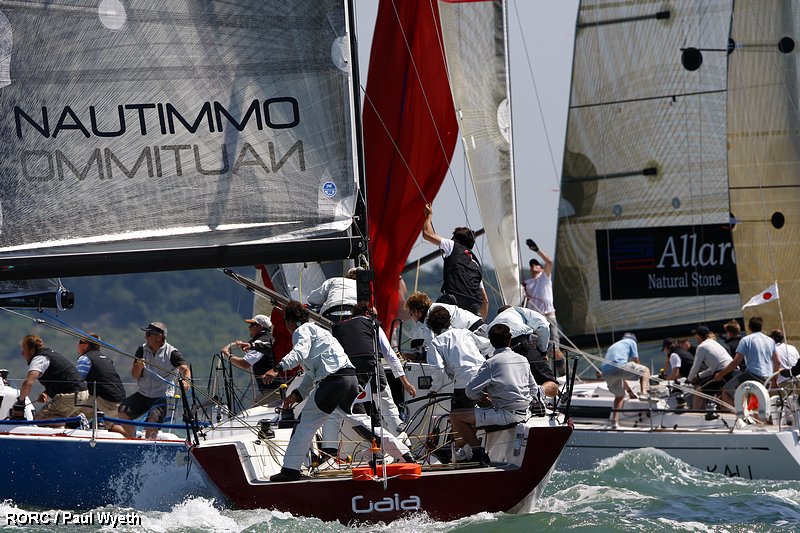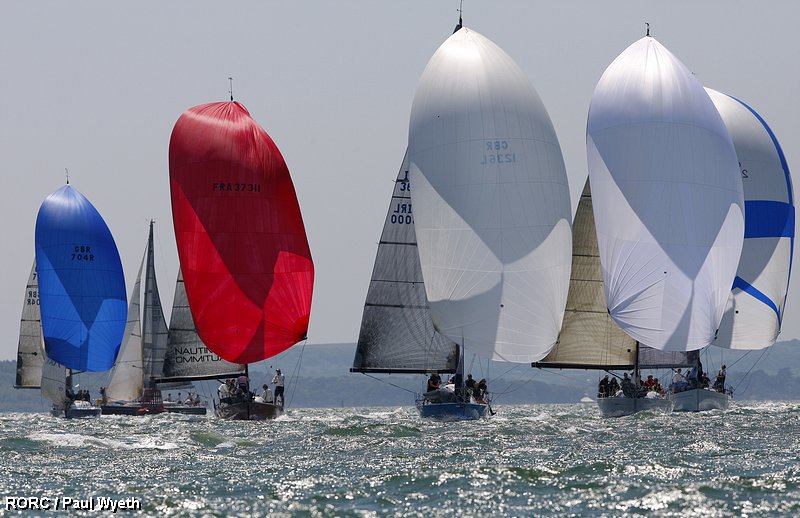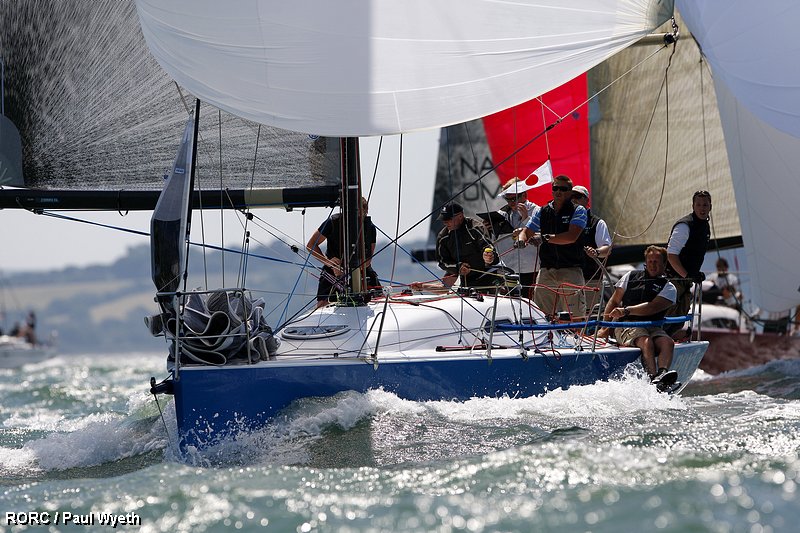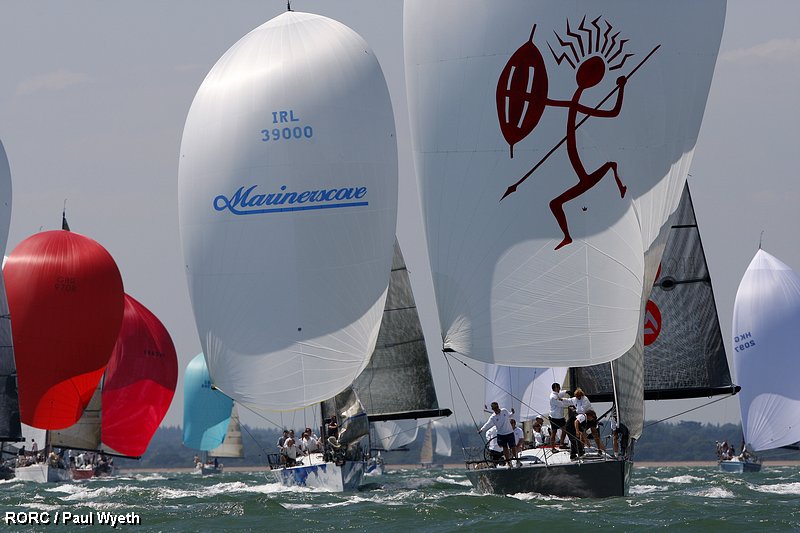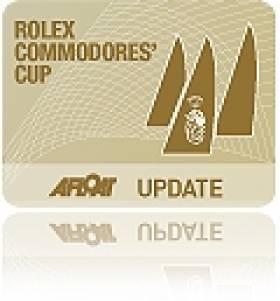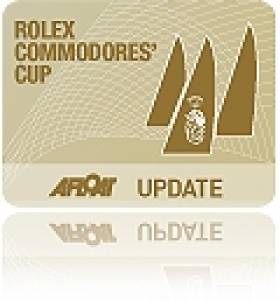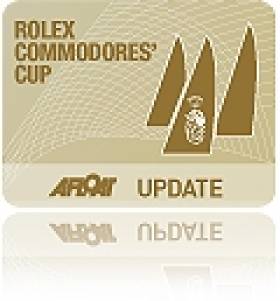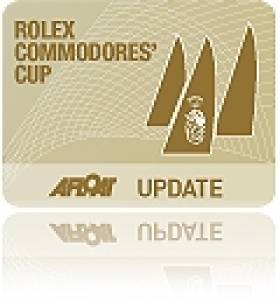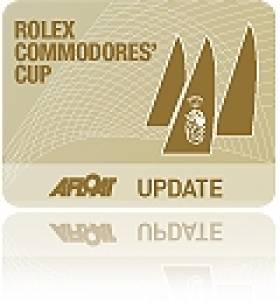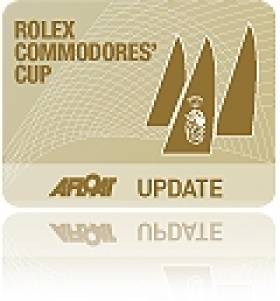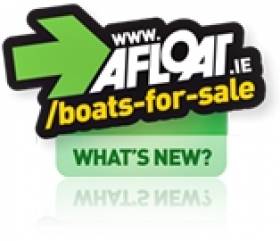Displaying items by tag: MarinersCove.ie
Commodores' Cup Celebration Dinner to be Held at Royal Cork
Team Ireland boats, Antix - Anthony O Leary, Marinerscove.ie - Dave Dwyer and Roxy 6 - Rob Davies and Andrew Creighton, will be represented on the night.
The dinner cost will be €30 and booking will be on first come/first served basis. Book with [email protected] or call 021 4831023.
Commodores' Cup Arrives in Ireland
The Rolex Commodores' Cup arrived back in Cork last night and winning team Ireland received a heroes welcome from the Royal Cork Yacht Club writes Claire Bateman.
In his welcome Admiral Paddy McGlade mentioned there were ten trophies for the event, eight of which were won by Team Ireland. One was for best British boat that obviously Ireland couldn't win, and the other was for best female crew category which they certainly couldn't win! When Team Leader Anthony O'Leary arrived he received a standing ovation and was joined by Andrew Creighton and his family.
Unfortunately marinerscove.ie skipper David Dwyer was still on his way home and could not be present but nonetheless marinerscove.ie was very much in the minds of all present.
In the Team Leader's speech Anthony made special mention of and paid tribute to Rob Davies of Roxy 6 and the hugely important part Roxy had played in the successful outcome.
He said Antix and marinerscove.ie had been around for some time but Roxy was a new build recently launched. He again expressed his gratitude for the unstinting and unswerving support so generously provided by Rob Davies any time it was requested for Roxy's campaign.
ICRA Commodore Barry Rose also spoke and gave a graphic description of the final race of the series and how well the Irish team coped with the conditions when all around them other boats were having major difficulties.
The formalities over, the Admiral rang the bell and the team members and their supporters enjoyed refreshments as they relived the seven days of the Rolex Commodores' Cup.
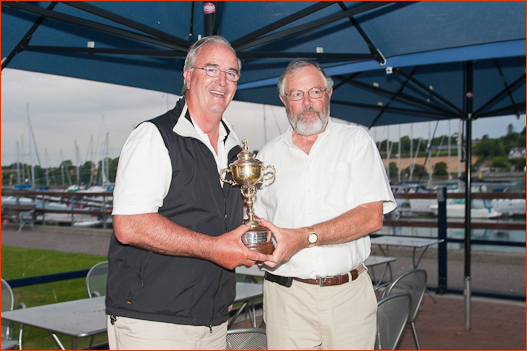
Job well done. Team Ireland Captain Anthony O'Leary is welcomed home by Royal Cork Admiral Paddy McGlade. Photo: Bob Bateman
Ireland Claims Victory in Blustery Rolex Commodores' Cup Finale
Ireland has done it. After mounting multiple teams, considered favourite going into both the 2006 and 2008 events but failing to win either, so the Irish boats Antix, marinerscove.ie and Roxy 6 today secured the Rolex Commodores' Cup for the emerald isle.
"It is delightful to finally have a chance to get our hands on the trophy," declared Anthony O'Leary, owner and helmsman of the Ker 39 Antix, the Irish team's big boat. "For all three boats, the Rolex Commodores' Cup has been the absolute pinnacle of what we have wanted to do this year. While Antix and marinerscove have been around, it is a credit to the guys on Roxy because they had a new build and got the boat in the water, and then there were all the attendant things you have to do. Owner Rob Davies, in fairness to him, didn't take a huge amount of persuasion to sign up and make the extra effort required to do it. We owe him a huge debt."
winn
Roxy 6's pro sailor Maurice 'Prof' O'Connell added: "We put in a massive effort and it is nice to have got the reward. Cowes is going to go ballistic tonight!"
The 2010 Rolex Commodores' Cup could not have finished on a better note. While the day dawned grim, with rain and visibility down to less than a mile, by start time at 10:30BST it was blowing 20+ knots and with the tidal effect this was churning up the Solent. With the weather mark not visible there was a distinct Irish hiccup on the first start when Antix collided with a French competitor and had to carry out a penalty turn.
"It was 110% our fault, but we are glad we got it out of the way," said O'Leary. "Fortunately with that amount of weather, there was always going to be a chance to have a come back."
And so it was on the run when, with the wind gusting to more than 30 knots and the sea seeming to come from all directions, that there were many instances of boats becoming overpowered and wiping out. This provided O'Leary and his crew with the chance they were looking for: "Down the first run Inis Mor tried to gybe, spun out and blew her kite to bits. White Heat had the same problem just ahead. Then we got to the bottom mark and our friends from Hong Kong trawled the kite, so we got inside them. Then we extended to the finish."
This was enough for Antix, despite her poor start, to post a second, typical of her scoreline this week, which has never featured a result lower than this.
One of the most dramatic scenes from the water today was of the Farr 45 Alice II in GBR White, streaming the top of her blown out spinnaker on the final upwind leg at the extent of the halyard.
"Coming into the leeward mark we saw 36.4 knots," recounted Alice II crewman James Read. "We were doing 17 knots in flat water and about one third of the chute was in the hatch and then thehead just caught the water and then 'zooop' it went out of the back, the sheets, the lot... We tried to blow the halyard but it wrapped up. So we flew it as a massive flag for the last beat! It was a bit of an air break."
In the two smaller classes, there were few boats that came off unscathed, other than the impeccable Irish. Peter Rutter's Grand Soleil 43 Quokka 8 in GBR Red had to retire when the bottom of their mast buckled. On the downwind legs there were many many broaches, the most dramatic being that of François Blossier's A-35 RealAx in France Red, which ended up with her masthead almost in the water.
"It was a little bit windy," admitted Blossier, who sails with a completely amateur crew and raced the Rolex Commodores's Cup four years ago on Pierre Follenfant's TBS. "We had a problem, because we took the big black spinnaker and we probably should have taken the smaller one. When we gybed we had a little bit of trouble with the pole...and that was it."
On board Blondie IV with the Hong Kong teams, Jamie McWilliam found the conditions exhilarating. "It was a perfect day, brilliant. I wish it had been like that all way. The funny thing about it, it was very tricky to catch a set of waves that worked because they were coming from everywhere. It was very sporty coming down the last run. The tack shackle of our tack line on the kite, which has a working load of 4 tonnes, exploded in a 20 ton gust. It was magic!"
McWilliam's Hong Kong team finished second to the Irish, on 117.5 points to Ireland's 73.5. However McWilliam was satisfied with the result: "I think if we'd been second having cocked it up, it would have been irritating, but the Irish guys sailed with great style and great skill and I'm absolutely delighted for them."
Andrew McIrvine, Commodore of the RORC said that his Beneteau First 40 La Réponse had been pushed to the limit. "We shredded a spinnaker. All our jammers started slipping. We have never put them under so much load before - they were tested beyond their working strain."
Otherwise McIrvine was pleased with the outcome of the regatta. "It has gone very well, particularly for the Irish who very much deserved their win. It was a very exciting day. As the French said it was 'un peu agitée'!' The results are good. Everyone had a good day. Ireland deserved it. They got so nearly there before. Now they have a hot team and they have gone for it properly and they deserved to win."
Top Five Teams – Provisional Overall Positions after completion of 8 races
Team / Points / Place
Ireland / 73,5 / 1
Hong Kong / 117,5 / 2
France Blue / 136 / 3
France Yellow / 167 / 4
GBR red /175 / 5
Full results and team lists are available at http://commodorescup.rorc.org/
Additional PR issued by ICRA;
Ireland wins Rolex Commodores' Cup at Cowes
As winds gusted to Near Gale force, Ireland's three boats in the Rolex Commodores' Cup delivered their strongest result since last Sunday's first day with a first and two second places in the high-scoring series finale. The Irish Cruiser Racing Association team of Antix, marinerscove.ie and Roxy will be presented with the trophy at the Royal Yacht Squadron at 5.00pm today.
Mist and driving rain clouded the racing area for the duration of the 90-minute race but presented no obstacles to the trio. Team captain Anthony O'Leary at the helm of Antix was able to recover from a pre-start incident with a French entry by taking a penalty-turn seconds before the start to avoid a protest and went on to score second place in Class 1.
Both marinerscove.ie skippered by Dave Dwyer and Roxy 6 subsequently steered clear of other boats and started well to score a race win and second place respectively. Overall, Ireland increased its lead to a winning margin of 44-points with Hong Kong placed second and France Blue in third.
"We finally managed to do what we've been trying to do for quite a very long time," commented O'Leary at Cowes Yachthaven marina shortly after coming ashore. "Thankfully we got the conditions that suited the Irish boats better than others; we are strong in those winds as we're well used to sailing them at home."
The win is the first major international trophy at Cowes in almost four decades of successive Irish teams who have come close to overall wins in the Admiral's Cup in 1979 and 1987 also as more recently in the Rolex Commodores' Cup that succeeded it.
"If you go back 30-odd years, you had Denis Doyle, Clayton Love and Archie O'Leary bringing boats here to sail in the Admiral's Cup," said O'Leary. "The demise of the Admiral's Cup led to the start of this event and Ireland has been sending teams for a very long time.
"We've been winning races and in the hunt in both previous events but seemed to fall at the final hurdle or not have that vital bit of luck when it counted. This time round I think probably we've had the strongest team we've ever had, with good focus and it managed to work out well."
The three-boat team was supported by shore-crew and representatives from the Irish Cruiser Racing Association both in Cowes and with extensive assistance from home as well. "This is the result that we had set our sights on and through the dedicated and united effort of everyone, we have won the Commodores' Cup for Ireland and Irish Sailing," said Barry Rose, ICRA Commodore. "We look forward to bringing everyone together at home for a full celebration of our sailors' achievements in Cowes over the past seven days."
"The fact that there are 50-plus people here for a week, trying to win a sailing event is proof enough that we want it and we were prepared to work very, very hard to get there and thankfully it came off in the end," said O'Leary.
Update: Ireland Going Well In Round the Island Race
Ireland is off to a great start this morning in the Round the Island Race. ICRA Commodore Barry Rose is out by the Needles. He says: "Antix is doing super in Class 1. Mariners is fourth on the water and ahead of most her Class One. Roxy second to Rockall, probably third in class" More as we have it.
keep up to date here:
http://commodorescup.rorc.org/fleet-tracking/2010-live-offshore-tracking.html
Send good luck messages here:
http://www.afloat.ie/commodores-cup/item/13716-commodores-cup-send-your-good-luck-wishes-here/
Ireland Continue to Lead Commodores' Cup
Two race wins and a third place for the Irish Cruiser Racing Association (ICRA) team at Cowes have extended Ireland's lead by ten points overnight as the event reaches its penultimate phase tomorrow with the Round Isle of Wight Race. Strong winds gusting to 25 konts are forecast and the team is focussed on avoiding damage.
Ireland has a 40.5 point lead over second placed Hong Kong and 49 points over third-placed France Blue.
Team Captain Anthony O'Leary on Antix won Class 1, continuing his consistent form of race wins and second places this week. Roxy 6 skippered by Andrew Creighton benefitted from an apparent navigational error by Hong Kong's Rockall III that was leading comfortably in Class 3 until a course change was missed and the Irish team boat won the race. Dave Dwyer's marinerscove.ie placed third in Class 2 in a race dominated by British boats La Reponse and Quokka 8.
"We have a very workman like approach to prepararing thoroughly for the 50-miler tomorrow," commented Barry Rose, Commodore of ICRA. "The course has lots of complicated corners and we expect it to be breezy. Its a big challenge that we're taking day by day; our plan goes on as it has from the beginning, concentrating on every detail to be as prepared as we can."
The race around the island counts for 1.5x bonus factor and will be especially tough in the forecast conditions. "The race around the Isle of Wight is going to be pretty long and pretty tough for the small boats," Maurice O'Connell, mainsheet trimmer on Roxy 6. "We're just going to keep doing what we're doing and hope that it all comes good."
A grim overcast start and lumpy wind against tide conditions gave way to brilliant sunshine and a summery finish off the Royal Yacht Squadron for the Rolex Trophy Day inshore race at the 2010 Rolex Commodores' Cup. Today's one race was held around multiple marks in the central western Solent starting in 18 knot southwesterlies with a wet beat through short chop before the tide turned and the wind dropped gradually through the race, ending at below 10 knots .
It was another solid day for the Irish team, leaders since the opening day of the regatta last Sunday. Their big boat, Anthony O'Leary's Ker 39 Antix and their small boat, Robert Davies' Corby 36 Roxy 6 both won their classes today while David Dwyer's marinerscove.ie posted a third. No other team was close to being as consistent today.
In the small boat class Roxy 6 came out on top partly thanks to a navigation error on the Hong Kong boat, Christopher Opielok's Corby 36 Rockall III [at the time of going to press this was subject to a protest for redress]. "We were very lucky," said Roxy 6's helmsman Andrew Creighton. "Rockall went to a wrong mark and they were ahead of us. With them making that mistake it obviously pushed us into first, although one of the French guys, Goa, came very close to us, but we had them by about 25 seconds."
Roxy 6 was only launched in April, but has had an intensive season at regattas throughout the UK and her native Ireland. Designed by Cowes resident John Corby, the 36 footer relished today's conditions. "The short Solent slap suits this sort of boat," said Creighton.
Back at Cowes Yacht Haven, Commodore of the Royal Ocean Racing Club, Andrew McIrvine stepped off the boat he co-owns with Peter Morton in buoyant mood. His Beneteau First 40.7 La Réponse won the mid-sized class today by two and a half minutes on corrected time ahead of past RORC Commodore Peter Rutter's Quokka 8.
"We just went fast," said McIrvine explaining today's result. "Upwind we go higher and faster than we ought to for this size of boat if you consider it is a cruiser racer. Downwind we go quick too. It is a semi-standard production boat and it does go extremely well." McIrvine acquired the boat this year from past Rolex Commodores' Cup winner Géry Trentesaux and has changed the bulb keel back to a fin but kept the go-faster carbon fibre mast.
"Tactically we didn't make any mistakes. The crew are fantastic. All the gybe sets worked perfectly. There were no foul-ups on any of the manoeuvres. They are a very well tuned team now," added McIrvine.
Second behind Antix, Bernard Gouy's Inis Mor in France Yellow had their best day yet, making it a Ker 39 1-2 in the big boat class today.
"Our spinnaker legs were better today with the asymmetric [spinnaker]," stated Laurent Gouy, the owner's son. "We have some difficulty when it is really downwind and when it is wavy we can compensate to slide downwind a bit better."
Behind them in third, the Hong Kong big boat EFG Bank Mandrake posted their best result of the regatta today. "I thought it was superb," said Nicholas Burns, co-owner with Fred Kinmonth. "I think we sailed as good a race as we could have done. We tacked about 20 times on top of Antix and she still beat us! She is going very fast at the moment, so I think our tactics will change now. We'll just go for the best position we can and not try and knock the Irish back."
As to the regatta generally, Burns said: "Very challenging, superb sailing, all the competition is extremely good and we're really enjoying it. It is colder than we are used to. We are used to Asian temperatures of 29-33 degrees Celsius. We have lots of warm ski gear on, but it has been really good fun."
EFG Bank Mandrake, a Mills 40 design, previously raced at the Rolex Commodores' Cup in 2006 as an Irish entry under the name Tiamat. She was shipped to the UK from Palma especially for this regatta and will head to Hong Kong afterwards. "It is great fun," says Burns of the regatta. "It is nice to have a team race with three boats in different classes. It is a really good idea. You feel you are sailing some of the best sailors in the world which is challenging."
At the end of play today the Hong Kong team lies second to the runaway Irish, but have been knocked back due to their small boat Rockall III's mishap, causing her to finish ninth (depending upon the outcome of their protest). From being 30 points astern of the Irish yesterday, the Hong Kong team is currently 40.5 points behind them. However the regatta is far from over with a race around the Isle of Wight coming with a x1.5 points co-efficient tomorrow (Friday) and a double points scoring inshore race to conclude the regatta on Saturday.
As RORC Commodore Andrew McIrvine puts it, "although the Irish have got away there is still almost half the points to play for. The weighting keeps the whole thing open right to the end of the event. At a lot of regattas by this stage it is signed sealed and delivered. We have still got a long way to go."
Conditions for the race around the Isle of Wight look set to be brisk with southwesterly winds gusting up to 25 knots forecast.
Crews competing at the Rolex Commodores' Cup will return to offshore mode tomorrow. The Irish will look to consolidate their dominance, whilst those chasing, particularly Hong Kong, will look to take advantage of any errors by the all but impeccably sailed leaders.
Top Five Teams - Provisional Positions after completion of 6 races
Team / Points / Place
Ireland / 47 / 1
Hong Kong / 87.5 / 2
France Blue / 96/ 3
GBR Red / 103 / 4
France Yellow /110 / 5
Ireland Hold Overall Lead But 'Dark, Wet Night' Ahead
The 17.00 BST sched showed Anthony O'Leary's Antix second among the big boats, David Dwyer's marinerscove.ie second in the mid-sized fleet and Robert Davies' Roxy 6 second among the small boats. With these results the Irish team would be on 44.5 points ahead of France Blue and Hong Kong tied in second on 71.5. GBR Red holds fourth on 86.5, followed by France Yellow in fifth.
As conditions improved following a damp and misty start to the 180-mile offshore race in the Rolex Commodores’ Cup, the three boats representing the Irish Cruiser Racing Association are maintaining good position at the front of their respective classes as the fleet settles in for a long night of beating westwards.
Other boats have already retired from the race after the breezy start off the Royal Yacht Squadron in West Cowes at 10.30am local time today. A brisk passage eastwards with a favourable tide saw the lead change as the fleet remained bunched. After passing the forts off Portsmouth and into open water close to Bembridge Ledge, the bigger boats started to pull away.
The 28-boats are racing in wind against tide conditions on the course westwards to Poole Fairway buoy before the smaller boats retrace their route back to Cowes for an expected finish during Wednesday. The larger boats have their courses extended further westwards from Poole towards Swanage.

“They’re setting down solidly after a hectic start,” said Barry Rose, ICRA Commodore. “Antix came out of it quite well on the northern end of the line while marinerscove.ie and Roxy were in a lot of traffic at the busy leeward end of the line. They’re now in quite promising positions.”
At the team briefing this morning, skippers and navigators heard that a lot will happen overnight which will be decisive as a front is expected come through which could lead to a change in wind and conditions; this could prove critical.
On estimated results this evening, Ireland continues to hold the overall lead of the event with strong challenges emerging from both France Blue and Hong Kong.
The 30 strong Rolex Commodores' Cup fleet shot off east down the Solent this morning with the wind and tide but under a grey rain-filled sky at the start of their high points scoring offshore race. The course for the 10 teams is full of zigzags taking them first out towards Selsey Bill while tonight they will be heading west along the bottom of the Isle of Wight en route for a mark off Poole Harbour. At this point the three classes will race slightly different courses before the run back east tomorrow morning that should see them finishing off a line to the west of Portsmouth Harbour sometime tomorrow afternoon.
At 17.00 BST Simon Henning's Alice II, a Farr 45, and the longest, highest rated yacht in the race, was approaching the Owers turning mark, the easternmost on the course, while the chasing pack were spread five to thirty-nautical miles astern of her. It seems likely that Alice II will steal a march on her Class 1 rivals, as her rounding of the Owers should coincide with the tide turning westbound, while those behind will face a further hour or two punching into it. Already Alice II in the GBR White team looks to be leading the big boat class on corrected time.
The absent Géry Trentesaux, the Frenchman who was instrumental in his country winning the Rolex Commodores' Cup in 2006 and 2002, would be proud. The First 40, Coup de Coeur, he co-owns with UNCL Commodore Marc de Saint Denis was leading Class 2 on handicap at 17.00 BST as part of the France Blue team. Meanwhile, in Class 3, it was the turn of the Hong Kong team to head the standings, with Christopher Opielok's Corby 36, Rockall III.
In the small boat class, Marc Alperovitch's A-35 Prime Time in France Yellow was holding fifth. Alperovitch said he had been pleased with their progress. Heading down the eastern Solent they had seen 20 knots but late in the afternoon the wind had dropped to 14 knots – less than forecast. "It has dropped earlier than planned," he reported. "Normally when the wind drops we should have a clear sky, but that is not the case at all. But maybe there is less pressure."
Just ahead of them, the crew on board Jim Macgregor's Elan 410 Premier Flair, lying seventh on handicap, were contemplating the night ahead and the lumpy conditions this evening heading west with the wind against the tide. "It was quite unpleasant earlier: wet and windy and horrible – good British summertime stuff," commented crew woman Jody Slater adding that on board they were seeing 16 knots from the southwest. "It is quite pleasant now. The wave action is a little uncomfortable, but apart from that is all right. It has stopped raining, which I am deeply happy about. Tonight hopefully won't be too unpleasant. It is supposed to be wind against tide. Unfortunately as one of the people taking seasickness pills, I don't look forward to the beating."
Owner Jim Macgregor had not managed to achieve his plan to use his boat's longer waterline length to shake off the smaller Corby designs. Macgregor, who pilots ships in and out of Poole harbour for a living and is father of the World Match Racing No.1 Lucy, said prior to the start that his crew, including Olympic 470 sailor Ben Saxton, comprised mostly inshore sailors. "Hopefully we'll stay awake tonight!"
This morning Simon Shaw, skipper on Michael Williamson's Summit 40 White Heat, the big boat in GBR Red, walked the course. "At around 5-6pm we get as far east as we are going to go and then it will be a long 12 hour beat all the way to Weymouth for us, around the back of the island. The tide is with us initially and then we are against on the mainland shore just under the Needles, so there will be a lot of tidal strategy in those areas and around Poole.
"It is going to be a really dark night. It is going to be wet – for us that beat is going to be the focus of the race really and the ability of crews to keep their boats trucking through the evening period. Our boat is a little tweaky so it will be doubly hard for us to keep it on the numbers in that environment." Shaw reckoned that they might rotate the helm and the main sheet trimmer to ensure they remained alert. They are expecting the wind to veer from the southwest back into the northwest tonight before settling back into the southwest tomorrow.
This evening as the teams prepare for a sleepless night on the rail, the British crews will be picturing the French teams sitting down below for a lavish dinner. In fact, the British might be getting the better deal. On White Heat they have a casserole to heat up for dinner, which will be eaten from dog bowls. On Prime Time Marc Alperovitch says they will be eating less palatable freeze-dried. "I love it – it reminds me of the Rolex Fastnet!"
Two yachts have retired to date: Cracklin Rosie (Class 1) and Artemis (Class 2) both from GBR Black.
The 2010 Rolex Commodores' Cup Long Offshore Race continues tomorrow, Wednesday, with the yachts expected to finish by the early afternoon. The forecast wind overnight is for 12 – 15 knots from the west and southwest. Tracking and provisional rankings available at: http://commodorescup.rorc.org/fleet-tracking/2010-live-offshore-tracking.html
Top Five Teams - Provisional Positions after completion of 4 races (Long Offshore not included)
Team / Points / Place
Ireland / 24.5 / 1
GBR Red / 49 / 2
France Blue / 51.5 / 3
Hong Kong / 54 / 4
France Yellow /59 / 5
The class positions that are updated every 15 minutes can be viewed online as follows:
Tracker: http://rorc.geovoile.org/commodorescup/
Class 1: http://admin.octracker.net/data/standings.aspx?id2=193
Class 2: http://admin.octracker.net/data/standings.aspx?id2=195
Class 3: http://admin.octracker.net/data/standings.aspx?id2=196
Ireland Leads By 20.5 Points after Day Two of the Commodores' Cup
After two more windward leeward races in bright sunshine and 15-18 knot winds Ireland's Antix scored a joint first and a second in the Rolex Commodores' Cup today. Marinerscove scored a fourth and a second. Roxy was seventh and first. After four races now sailed on the Solent, Ireland leads by 20.5 points from UK Red. France Blue is third on 51.50 points. More reports and photos later.
Commodores' Cup: Ireland is 'Team to Watch'
The pre-event press release says 'no clear cut favourite but Irish eyes are smiling'. It's the kind of pressure Ireland's three boat team can do without after so many near misses in this event. But as they go afloat this morning for the first race there is no dismissing the fact that Ireland's single boat is seen as a major threat, especially if as forecasted, the winds on the Solent are moderate to strong. (You can send team Ireland good wishes HERE.)
International entries from as far afield as Hong Kong and South Africa have descended on Cowes ready for the start of the biennial Rolex Commodores' Cup.
As usual the event is for teams comprising three boats in different IRC rating bands, the boats ranging from 35-45ft in size. Teams are national with at least 50% of the crew coming from the country they are representing. The Rolex Commodores' Cup is also strongly Corinthian: only two professional sailors are allowed on the Class 1 boats and just one aboard Class 2 and 3 entries.
This year, the tenth edition of the competition, 10 teams are competing, the largest contingent coming from France, who are fielding four teams; GBR has three teams and Hong Kong, Ireland and, for the first time, South Africa each with one. Whilst the team numbers are down from two years ago, "the top four or five teams are as good as they were last time," says Eddie Warden Owen, CEO of the event's organisers, the Royal Ocean Racing Club.
In terms of the form, Warden Owen thinks the Irish will be ones to watch, as they have certainly been in the past, although they have never won; "they are very competitive, they seem highly focused and they have some very good amateur sailors on board as well as professionals." The Irish team is led by experienced Rolex Commodores' Cup skipper Anthony O'Leary and his Ker 39 Antix.

Dockside in Cowes for the Rolex Commodores' Cup. Photo: Kurt Arrigo
South Africa and Hong Kong also have strong entries, the latter having learned from competing here two years ago, again with the driving force of Jamie McWilliam behind them.
Warden Owen reckons that the dark horses at this event are the British and French teams. "The unknowns for me are the French teams because there are some good individual boats, but how they play out overall, I don't know."
Defending champions from 2008 are GBR Red, where the only return entry is former RORC Commodore Peter Rutter, this year skippering Quokka 8, the mid-sized yacht. Rutter's new vessel is a Grand Soleil 43, a sistership to the most successful yacht at the 2008 event.
Rutter was instrumental in picking his GBR Red team mates in Michael Williamson's Summit 40 White Heat, as the Class 1 boat and Jim Macgregor's Elan 410 Premier Flair in Class 3. "We are very much a tight team – we learned that from GBR Red last time. It is going to be an interesting regatta because it looks like there are going to be some very light days and some very heavy days."
The equivalent to GBR Red among the large French entry is France Yellow, which includes repeat entrants to this event, Philippe Delaporte and his J/122 Pen Azen and Marc Alperovitch and Jerome Huillard's A-35 Prime Time. They are joined by Bernard Gouy's Inis Mor - a British designed Ker 39 with an Irish name, points out skipper and owner's son, Laurent Gouy. While this is Inis Mor's first Rolex Commodores' Cup, the Gouys have for the last years been alternating Cowes Week and the Rolex Fastnet Race with Cork Week and the Round Ireland – this year moving on to this event.
Like GBR Red, France Yellow also organised themselves as a team and presented themselves to the RORC's French equivalent, the Union Course Au Large (UNCL), before Christmas. Inis Mor is one of the most successful IRC boats on the French circuit and usually podiums at the event in which she competes. As to how he thinks they will get on this week Laurent Gouy will not be drawn: "I would not dare to say! It is very complex."
The other French team that stands out is France Blue featuring Nicolas Loday and Jean Claude Nicoleau's familiar Codiam, a Grand Soleil 43, but also Marc de Saint Denis and Géry Trentesaux's First 40 Coup de Coeur, although we understand the wily Trentesaux, a Rolex Commodores' Cup veteran and winner in 2006 will not be in Cowes until Friday. The weak link in France Blue could be Samuel Prietz' X-40 Goa, but only because the boat is still new, having been launched in May.
Making one of the greatest efforts to compete in this year's event is Philipp Gutsche and his Mark Mills-designed Landmark 43, Windpower, which was shipped up from the southern hemisphere to be the South African team big boat.
"It's on my bucket list! Why not at my age?!" says Gutsche of why he is here. "We have done very well this year in South Africa in IRC and we won the South African Championship, in May. We have a good crew and a good boat - why not test our mettle against everyone else for the fun of it?"
"As a team I hope we will do very well. We'll be starting off as the weakest of the three boats. Cowes and the Solent are not easy, especially for foreigners." Gutsche had never sailed here before he competed at this year's Cowes Week. "It has been great fun. We are looking forward to it."
The racing format over the next week remains the same as it was in 2008, with a mixture of inshore races in the Solent plus a 24-36 hour long offshore race starting on Tuesday and a race around the Isle of Wight on Friday. The event culminates in a double points scoring inshore race on Saturday.
Conditions this week are expected to be particularly difficult, with light winds on some days, combined with some of the most powerful tides of the year. For example, today (Saturday) the famous Brambles Bank cricket match took place; the one-day each year the tide is so low as to expose the sand bank in the middle of the Solent. As Simon Shaw, skipper of the GBR Red big boat White Heat points out "I have never seen so much tide – we've seen 4 knots!" Conditions for the first few days of the regatta look set to have the wind from north, typically an awkward wind direction in the Solent, and around 7-14 knots. "There is discrepancy about how windy. Some people think on Tuesday there is going to be a load more breeze. I'm not so sure. Expect it to be from the north, fickle and swingy," predicts Shaw.
Whatever the conditions, the spirit and camaraderie exhibited on shore over the past couple of days of measurement and registration bodes well for a hard, but fair fought week of competition.
e months to go to the 10th edition of the biennial Rolex Commodores' Cup, the international fleet has every prospect of being one of the more exotic in recent events. A noteworthy success in these straightened times. The headline foreign contingent is perhaps South Africa, participating at the regatta for the first time. Hong Kong has confirmed it will be back following its happy venture in 2008. Thereafter, the northern European teams – Ireland, France and the United Kingdom - that are the traditional backbone of the event - will be present in numbers. Organisers, the Royal Ocean Racing Club, anticipate a total of 12 teams. Racing is from 15 to 21 August, with close of entry on 12 July.
The Rolex Commodores' Cup is a weeklong series mixing inshore racing on the waters in and around The Solent, the body of water separating the Isle of Wight from the mainland United Kingdom, with an offshore course that takes the fleet out into The English Channel and a course round the Isle of Wight. All of the racing is typified by one thing. Comprehensive knowledge of the tides and currents affecting these areas is essential. Furthermore, it has been proved time and again that is not just the team with the best boats or the best sailors that wins. It the team that is the best prepared in all aspects.
Take the Hong Kong team, led by Jamie McWilliam. Having finished fifth overall in 2008, surprising many of the more seasoned campaigners in the process, McWilliam and his teammates were resolute in their determination to return. Not just to participate, mind you, but to have a crack at winning. "In 2008 we arrived with a crew that had trained hard but which had never seen the boats before the regatta, as they were either charters or brand new. This meant that we spent quite a bit of important time just before the event working on the boats instead of working on our speed, and as a result we were still learning about the boats during the series. Our team this time was determined to avoid that mistake," comments McWilliam, explaining that this time, "all the boats are owned by Hong Kong owners and we therefore have much more time [to prepare]. Our full team will be at the UK IRC Nationals in late June and we are scheduling other weekends over the summer for the boats to have new sail trials."
It is a tall order to travel almost halfway around the world to participate in a three-boat team event. The three yachts needed to compete range in size, roughly, between 35 and 45 feet. There are crews to be identified, accommodation and travel to be arranged. McWilliam is clear that it is worth the effort, "it's always exciting going to an event where you think you have a chance to win but where you know you're going to have to really perform to achieve that. It provides a great combination of expectation, anticipation, and nerves. Combined with the knowledge that we are representing the small sailing community in Hong Kong, it's a really exciting deal."
The Hong Kong team is made up of Rockall III, a Corby 36 owned by Chris Opielok, in the small boat slot. 'Opie', as he is known, is a Hong Kong sailing legend, having won two Admiral's Cups for his native Germany. Rockall III is the former Rosie, which has a dominant history in UK & Irish IRC racing. The middle boat is Blondie IV, a Mills (King) 40 chartered by Anthony Day from Helmuth Hennig, both very well known Hong Kong racers. Blondie was 2nd in class in Rolex Commodores' Cup 2008 and has an exceptional track record under her former owner. The big boat is Mandrake, Nick Burns' Mills 40.5, formerly Ngoni and Tiamat. As Tiamat, she had an outstanding Rolex Commodores' Cup in 2006.
McWilliam acknowledges the difficulties involved for foreign teams, particularly getting the right boats in the right condition to the venue when they are located more than a delivery trip away. He clearly believes more countries should look more seriously at the possibilities, "I would definitely encourage other teams to participate. The Solent puts unique and intense pressure on crews and seemingly trivial moments turn out to be really critical, like a down tide bottom mark rounding where you've got to be perfect in order to hold your lane to get out of the current. I also believe that the best team here has always won the event, and that's the best recommendation I know for a regatta."
The Hong Kong team is looking forward to renewing rivalries with some of the teams it competed against in 2008. They are not here to make up the numbers, "we really enjoyed the event in 2008 and feel that the event is a good match for the type of sailing we do in Hong Kong, and therefore represents a great opportunity for Hong Kong to compete against peers and find out where we rank. We were happy with our 5th position in 2008 but saw it very much as an initial effort and unfinished business."
The Rolex Commodores' Cup will be held off Cowes, Isle of Wight, from 15 to 21 August. Entries, which must be made by Member National Authorities, close on Monday 12 July.
Irish crew list HERE
Entry List HERE
You can send team Ireland good wishes HERE
Ireland's Commodores' Cup Yacht for Sale at Euro 295,000
Ireland's Commodores' Cup boat 'Marinerscove.ie' skippered by Dave Dwyer is up for sale priced Euro 295,000. The Mills 39 is available after next week's Rolex Commodore Cup according to an advertisement on an online advertisement in the UK, click HERE. Described as 'probably the most successful IRC boat ever' the yacht, built by Vision Yachts of Cowes in 2006, is the current UK and Irish IRC champion. The yacht is constructed of E Glass, S Glass and Corecell. Mast from Formula Spars of High Modulus Carbon and has been professionally maintained, according to the site.
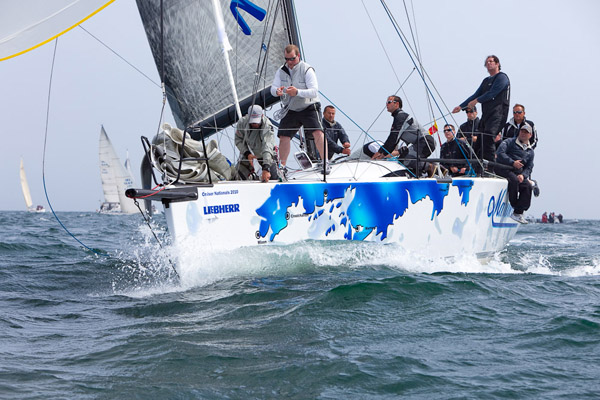
Marinerscove.ie is for sale and available after next week's Commodores' Cup. Photo: Bob Bateman
One of the most competitive fleets ever assembled enjoyed some spectacular sailing conditions (as Paul Wyeth's photos over the fold show) on the first day of the 2010 RORC IRC National Championship writes Louay Habib.
Charles Dunstone’s TP52, Team Origin Rio, had a perfect start to the championship, scoring three straight bullets in IRC Super Zero. “Rio just lights up in these conditions; it was absolutely fabulous out there today,” commented Charles Dunstone after racing.
There was an intense battle on the water in IRC Zero. Hong Kong’s Rolex Commodores’ Cup big boat, Mills 40, EFG Bank Mandrake, is in pole position after three races. Joint owner, Nick Burns had this to say dockside: “That was pretty hot racing out there. Great fun and fantastic stuff. We were delighted to take two wins but our disappointing last race has left us a bit perplexed. We seemed to lose boat speed upwind and downwind. Perhaps we picked up something on the keel but we really don’t know what the issue was.”
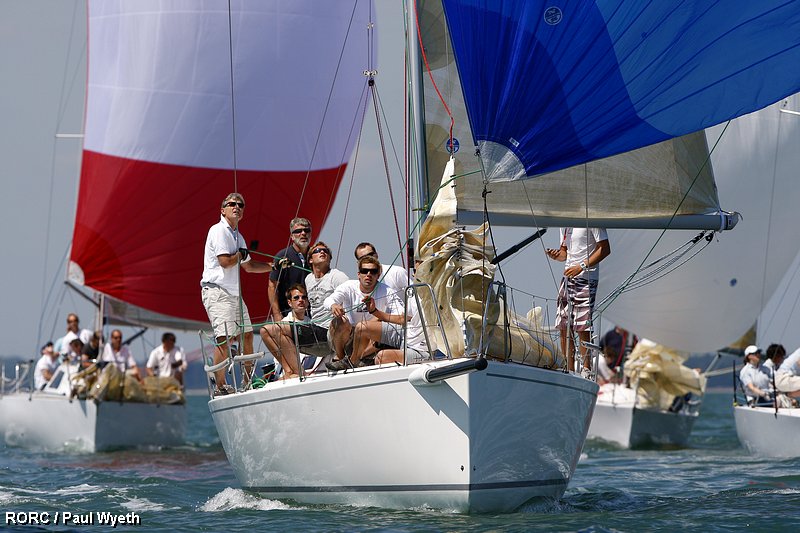
In IRC One reigning RORC IRC National Champion Dave Dwyer’s Mills 39, Marinerscove.ie, got off to a great start winning the first two races, but the last race of the day did not go according to plan. Tactician Andy Beadsworth explains: “The first two races went well for us, we sailed our own race and as the fastest boat in the class we could go our own way but it all went wrong in Race Three. We were too eager at the start and with close to three knots of tide we were over the line and had to go back. After that we misjudged a port-starboard and ended up doing penalty turns. However the recovery was good and we managed to claw our way back through the traffic for a third place.”
Marinerscove.ie leads IRC One after the first day. Peter Rutter’s Grand Soleil 43, Quokka 8, is in second place with Robert Davies’ Corby 36, Roxy 6, in third.
In IRC Two, Marc Alperovitch and Jerome Huillard’s A 35, Prime Time, had a disappointing first race but it was all smiles for the French team after that with two bullets to end the day top of the class leader board. Chris and Hannah Neve’s First 35, No Chance, is lying second over night with Steve Northmore’s A35, Waterjet.co.uk, in third place.
IRC Three may be the smallest class at the championship but virtually the entire class enjoyed a very close squabble in the western Solent. Mike and Jamie Holmes’ J 97, Jika Jika, came out on top after three races. James Morland’s Quarter Tonner, Menace, slipped up in the last race of the day but holds onto second place. Louise Morton’s Quarter Tonner, Anchor Challenge, has a very consistent day and is lying third.
Three races are scheduled for the second day of the Championship today. All of the competitors will be hoping for another fantastic day’s racing in the Solent.
Full results from Day One of the RORC IRC National Championship can be found at www.rorc.org
